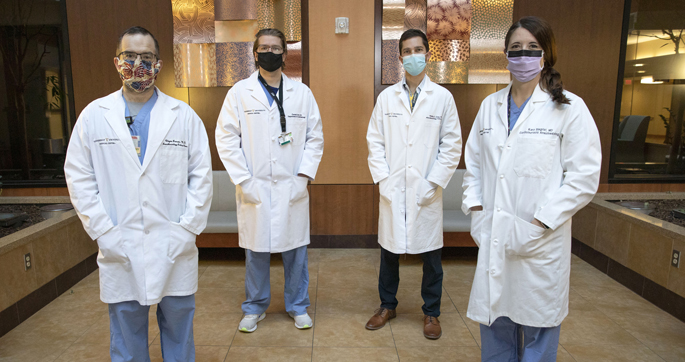
by Matt Batcheldor
Liver transplants have traditionally required a high volume of transfusions of blood products, which comes with several downsides. The products are costly to patients — as high as $15,000 on top of the expense of a transplant. And they are sometimes not well accepted in patients because they degrade over time and are derived from multiple patients.
The best blood, of course, is always one’s own, said Clayne Benson, MD, director of liver transplant anesthesia at the Vanderbilt Transplant Center. Benson is pioneering new approaches to conserve blood products by better utilizing a patient’s own blood, which has the potential to improve outcomes in patients, cut health care costs and conserve the limited supply of donated blood — especially important in the time of COVID-19, when occasional shortages of products have occurred.
One approach Benson is studying is Acute Normovolemic Hemodilution (ANH), which is used for liver transplant patients who come into the operating room with adequate red blood cell and platelet counts and whose blood is clotting properly.
“We will take their own blood out of them and replace that blood with other fluids, like generic fluids we use,” said Benson, assistant professor of Clinical Anesthesiology. “You dilute out the blood that is left and so when they bleed that diluted blood, you’re not wasting much. And when they need their own blood back, you give it back to them. That allows you to give a smaller amount of blood products from the blood banks, so less foreign blood is used.
“We’ve been able to show that you can do that, and you can save money and foreign blood.”
Though it is being studied in the liver transplant population, the method could also be useful for other organ transplants and trauma cases requiring large blood transfusions, Benson said.
Kara Siegrist, MD, assistant professor of Cardiothoracic Anesthesiology, has been working alongside Benson in the ANH research.
“The ANH project is just one example of the advancements in exemplary patient care we strive to achieve to provide the best, safest and most cost-effective health care to some of the sickest patients in the hospital,” she said. “With the volume of liver transplants we do at VUMC, even little cost savings on an individual level can add up to big savings for the hospital system. I’m proud to be part of such a wonderful multidisciplinary team of physicians and nurses all working together for the good of our patients.”
Benson’s interest in blood product conservation was inspired by necessity, when he served in the Special Operations Surgical Team (SOST) in the Air Force about a decade ago. The team served injured military personnel in the field, such as in Afghanistan, where the traditional assortment of blood products are not available. In that situation, medics would take blood from other soldiers whose blood matched the injured, which is fresh and not degraded.
That experience piqued his interest in applying those lessons to the hospital setting. Another area of study is retrieving the blood of organ donors to go along with organs at the time they are retrieved, then transfusing the blood into donors’ bodies, which is not typically done today.
Benson noted that VUMC is part of a multicenter study of a device called TransMedics, affectionately known as Heart in a Box. Blood from heart transplant patients is retrieved at the time the heart is removed and then perfused into the organ en route to VUMC for transplant. Preliminary data shows the hearts can be preserved longer before transplant, expanding the supply of organs. Benson foresees expanding that program to livers.
“All these things require a team,” Benson said. “I’ve been lucky to have on the surgical side, Sophaclis Alexopoulos, MD, chief of Liver Transplantation, who has been very supportive of all of these things, in addition to all the surgeons on the team. When I first became the director of liver transplant anesthesia, we didn’t do ANH, but some team members on the anesthesia side were enthusiastic about it, as well as some of the surgeons. But it took some time and once they saw the benefit of it, then they were all on board.”












